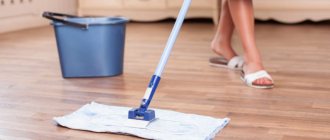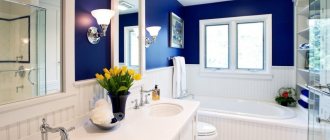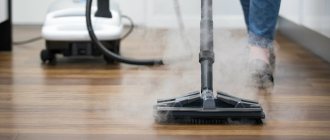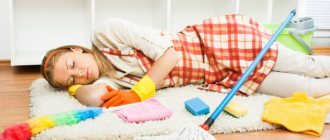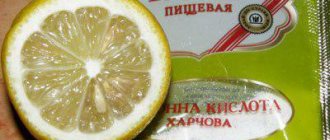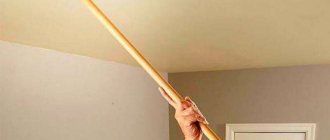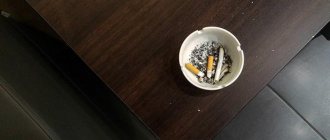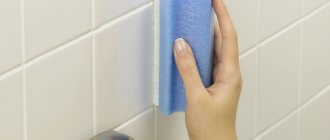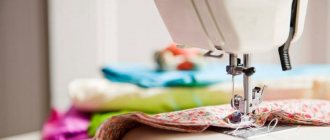Laminate is a very popular floor covering that can often be found in residential buildings. Let's talk about how to wash laminate flooring and how to properly care for it.
Laminate flooring will fit perfectly into any interior, and if you follow the rules of regular cleaning, it will also decorate any room with its shine.
Laminate flooring is quite durable and wear-resistant, but errors in maintenance lead to scratches, abrasions and corrosive dirt on its surface.
Features of laminated coating
Laminate flooring consists of boards that are connected to each other using a “lock”. Together, as a rule, they form a flat surface without noticeable joints.
There are two types: household (21-23 class) and commercial (32-33 class). The first one is usually laid at home, and the second one is more durable - in offices, for example.
You can also sometimes see the “degree of wear resistance” markings on the packaging. There are three of them: minimal (AC1, AC2), medium (AC3, AC4), high (AC5).
There is also a moisture resistance marking:
- DPL – non-moisture resistant;
- DPR – more moisture resistant, wet cleaning once a week is acceptable;
- HPL – with increased strength. Cleaning with water is allowed once every 5 days;
- CPL is a floor covering with high moisture resistance. It is possible to use a washing vacuum cleaner.
The name “laminate” is translated from Latin as “layered”. And this is no coincidence, since the canvases themselves consist of four layers:
- the bottom one – stabilizing – is made of moisture-resistant paper, which is impregnated with a special composition;
- then a sheet of chipboard or fiberboard - pressed sawdust;
- followed by a photograph to give the coating the desired pattern;
- protective film on top.
Yes, overall a fairly strong product is formed, but it still has weaknesses. Caring for it must be careful and constant.
How to properly clean a laminate floor?
Start with dry cleaning. This is especially true for low-class laminates. Take any tool: a broom, a dry mop or a soft cloth, a vacuum cleaner with a soft attachment. Try to move the selected tool along the boards so that dust and fine dirt do not get between them. Always move from the far corners towards the exit. In general, there are almost no restrictions for dry cleaning. And it’s best to do it daily to avoid strong, stubborn dirt and scratches from small debris.
If necessary, do wet cleaning. But try not to wash your laminate floor more than once every one and a half to two weeks. Boards of a higher class can be washed more often - once a week. You need to start by choosing a tool. The requirements for it are the same as for dry cleaning - avoid rough materials and unnecessary elements that can leave scratches. A mop with a microfiber attachment is ideal. In addition to the fact that this material is quite soft, it washes well and absorbs water well. If you don’t have such material at hand, you can take wool, soft cotton or synthetics. Keep in mind that for washing you need a slightly damp cloth.
Advice! A mop with a rope cloth absorbs moisture the worst - it can seriously damage the cloth.
Next you need to choose a cleaning agent. Although it is still better not to use household chemicals, but to wash only with hot water (but not boiling water!) - this way the effect on the protective layer of the fabric will be much softer. In addition, ordinary water does not leave streaks. If there is a need to refresh or remove stains, choose a product special for this coating. If you are unsure about the safety of a cleaning substance, it is best to test it on a small, inconspicuous area before cleaning the entire floor.
Advice! After wet cleaning, it is advisable to walk with a dry cloth so as not to leave moisture on the floor.
Prevents contact with moisture and increases service life
- Place indoor flowers in pots placed on the floor in deep trays so that excess water does not overflow when watering.
- Use blinds and curtains on windows to reduce constant sunlight on the floor surface. Shade rooms and diffuse direct rays, then the color of the floor will remain rich and the texture smooth and shiny.
- Do not rub in mastics or any other wax emulsions. The use of these products will increase the risk of injury, and the service life will only be reduced. Achieve a glossy shine by rubbing with a dry cloth or using approved chemical compounds.
- Wipe matte laminate with a dry cloth daily, using light movements without pressure.
- Equip play areas in the nursery or areas near armchairs, sofas, and beds with rugs. This will protect the top layer from stains and abrasion.
How to clean laminate flooring from difficult stains?
- Dye. You can wash it with a cotton pad soaked in acetone or ethyl alcohol.
- Putty. Remove with a damp cloth using gentle movements. Cured putty can scratch the laminate.
- Chewing gum. Apply ice. When the gum hardens, remove it with a scraper, being extremely careful.
- Ink stains. Wash thoroughly with acetone.
- Traces of blood. Wash off with glass cleaner.
- Streaks from shoe soles, shoe polish. Wipe with a cloth soaked in vinegar.
- Zelenka, iodine. Rub the stains with rubbing alcohol.
- Coloring food products. Remains of juice, coffee, wine can be washed off with liquid soap.
- Traces of tape. White spirit will help in the fight against them.
We remove specific stains
Often, various substances get on the floor, leaving stains. Some spots need to be dealt with with special means, and they should be used exclusively in the area of the resulting defect. To remove stains from laminate flooring, determine the source of contamination, and then follow these tips:
| Pollution | Solution | |
| Marker | It is easy to remove traces with a regular solvent. | |
| Ink | They will be washed off with soapy water. | |
| Blood | A fresh stain will be removed by a product intended for cleaning glass (windows, display cases, cabinet doors, etc.). After spraying the composition, the surface of the laminate should be immediately wiped with a damp cloth. Regular (pharmacy) hydrogen peroxide will quickly remove old and dried drops of blood. | |
| Wax, chewing gum | These substances must be removed only after hardening and drying. The main part of the adhesion is removed with a knife (non-metallic!) after softening with a hot rag. Residues are wiped off with a cloth soaked in white spirit. | |
| Nail polish | Everything will be corrected by ordinary acetone, which must be removed immediately after application. | |
| Wine, coffee or tea | Old stains can be wiped off with a soaked rag, and dried stains can be wiped off with any special product for cleaning laminate flooring. | |
| Colour pencils | These stains can be removed with a soft eraser or a dry nylon cloth. | |
Especially drops of glue or paint should be highlighted. It seems impossible to remove them from the surface, however, there are two products that can cope with such contaminants. Experts recommend using alcohol or acetone. You need to apply the substance to the stain, and after 3-4 minutes, wipe everything off with a damp cloth.
What can't be used?
So, the first rule is that floors made of such material should not be washed with large amounts of water. But there are still products that should be avoided when cleaning:
- Aggressive substances. For example, containing chlorine. This component can eat away the design and color, and spoil the wooden canvas as a whole.
- Solvents. Acetone helps in the fight against stains, but you shouldn’t get carried away with it. This liquid quickly dissolves the protective layer.
- Powders. Small granules and lumps easily scratch the protective coating of the board. It's best to avoid them when cleaning.
- Hard old rags and sponges with abrasive elements can also cause mechanical damage.
- Acids and alkalis. These substances in cleaning products corrode the top layer, it becomes unnaturally matte.
- Wax, mastic, silicone. These things are used to add shine to the flooring. But it’s better to leave such work to a professional.
Pre-cleaning
We remove large debris from the floor. At this stage, you will need to remove elements that can scratch the protective layer - glass, toy parts, plastic, metal. The next step is to remove the sand that accumulates when walking indoors in shoes. If there are traces of plasticine and other viscous substances on the surface, you can use a silicone spatula or wooden spatula.
Sand and other dirt are removed with a soft bristle broom and dustpan. If a vacuum cleaner is used for cleaning, you need to make sure that the brush has soft fibers; with their help, you will be able to remove threads, dust, and hairs from hard-to-reach places and corners.
Laminate cleaning products
There are a huge number of products on the household chemicals market created specifically for this type of floor. But not only that: inventive housewives, from their own experience, also helped to compile the following list of improvised means.
Folk
- Vinegar. At home, you can wash laminate floors by mixing vinegar with water in a ratio of 1:4.
- Baby shampoo. The most harmless method. You can wash a laminate floor by dissolving 5 tbsp in half a bucket of water. l. shampoo.
- Ethyl alcohol is used when cleaning to remove stains. It is diluted with water 1:5. This solution can be washed quite often. They can also be used to complete general cleaning.
Professional
Even with regular gentle cleaning, maximum cleanliness cannot be achieved. More thorough washing is still required every 3-4 weeks. And then professional tools will come in handy. They are specially designed specifically for laminate flooring and therefore cope perfectly with dirt on it, without leaving damage or streaks. They often also have nice bonuses: for example, an after-wash product protects the coating after washing or softens the water. Many of them are sold in hardware stores, some will have to be looked for in online stores:
- "Bagi Laminate". A relatively inexpensive product made in Russia. Contains flax oil. Also suitable for daily cleaning.
- "Laminol". Also a domestic product. When you need to wash laminate flooring without streaks, use Laminol. It has several more advantages: it does not require rinsing, softens hard water, and contains orange oil.
- "H.G." Dutch production. In its usual form it can be used as a stain remover, and if diluted with water, it can wash the entire floor. Also, after washing, “HG” leaves a protective film and a pleasant aroma.
- "Emsal Laminate". German production. Well suited for any type of dirt: stains from glue, grease, wax and paint. It also covers the floor with a thin film.
- "Mellerud". Produced in Switzerland. Considered one of the best in the world.
- "Unicum". After washing with this substance, there are also no streaks left and shine appears. It also kills bacteria and has a pleasant aroma.
- Starwax. Emulsion from a French manufacturer. It cleans the laminate well from dirt, but does not leave any shine. There is no need to wash it off. Housewives who have used it recommend diluting it in an amount of water twice as much as indicated in the instructions. Perhaps the product is more suitable for cleaning areas where people wear outdoor shoes.
- "Denkmit." The peculiarity of this product is that after washing the floor, a wax film remains that does not allow moisture to pass through.
- Mr Proper. You can call it universal. Quite quickly removes dirt from various floor surfaces. It washes off easily and smells nice.
Washing vacuum cleaner
This cleaning tool has both pros and cons. Let's consider all the advantages and possible risks.
Pros:
- High cleaning speed.
- High-quality floor cleaning.
- Various attachments and modes.
Minuses:
- Abundant use of water – i.e. Suitable only for high moisture resistance laminate flooring. It is not recommended to vacuum even the HPL type.
- The surface of the planks may lose color.
- Brushes can damage the floor surface.
Steam generator
There is a lot of controversy around the steam generator in relation to laminate, but most housewives will agree that this tool is dangerous for such a coating. Hot steam is the worst thing you can think of for a laminate floor, because... it can destroy even the most wear-resistant.
Instead of a steam generator, you can use an alternative tool - a steam mop. It does not have such an aggressive effect on laminate flooring. But you need to use it extremely carefully: steam can get into the joints.
Video
We invite you to watch videos on the topic of cleaning laminate flooring at home:
About the author:
Found a mistake? Select the text with the mouse and click:
Do you know that:
Fresh lemon is not only suitable for tea: clean dirt from the surface of an acrylic bath by rubbing with half a cut citrus, or quickly wash the microwave by placing a container of water and lemon slices in it for 8-10 minutes at maximum power. The softened dirt can simply be wiped off with a sponge.
How to make laminate shine?
To make the laminate shine, mix 1.5 tbsp. vinegar, 1 tbsp. lemon juice and 2 tbsp. warm water. Then add a few drops of dishwashing liquid. Use the resulting mixture to polish the laminate. Don't wash it off. Open the windows.
There is another option for adding shine to the laminate. For 5 liters of water you need 2.5 tbsp. l. gel (low PH) and 1 tbsp. l vinegar. Treat the floor surface with the windows open, without rinsing.
How to remove scratches?
Small scratches and abrasions on the laminate can be hidden using a flannel cloth dipped in vegetable oil. An ordinary eraser is suitable for the same purposes. There is also a special wax pencil and polish.
But to restore the surface and mask deep dents and chips, you will need a special paste and putty. They need to be applied to the damaged area and left for 24 hours. After 24 hours, the area can be sanded and varnished.
Tips for care and use
- Try to stick to the “golden mean” when washing the floor: not often and not infrequently, so as not to spoil it with constant moisture or stagnant dirt.
- Do not walk on laminate flooring in heels. It is better to wear soft house shoes or go barefoot.
- Put pads on furniture legs to avoid scratching the floor.
- If liquid gets on the laminate, try to dry the area immediately with a dry, clean cloth.
- If scratches, dents, or chips appear, eliminate them immediately, otherwise complete destruction of the canvas will not be avoided.
- If you find severe contamination, remove it immediately. Dirt is quickly absorbed deep into the laminate and then cannot be removed.
Removing scuffs
Most often, abrasions on the coating appear in common areas - in corridors, in the kitchen, on thresholds. If you lay a coating with poor wear resistance, then you cannot avoid the appearance of abrasions.
When caring for such a floor, it is important to use a protective coating so as not to have to solve the problem of how to get rid of scuffs later.
Wax, just like removing scratches from laminate, helps hide scuffs. To do this, you need to rub the worn area with wax, going slightly beyond its border. The area is then polished with a soft cloth. You will have to constantly wax the floor to protect the coating from wear and tear.
